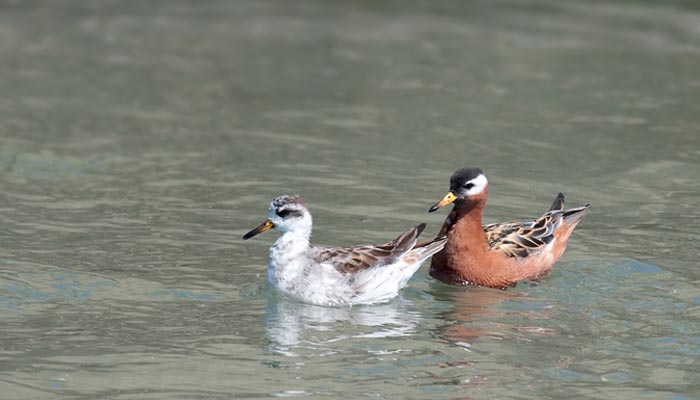
English: Red Phalarope, Grey Phalarope
Russian: Плосконосый плавунчик
Mongolian: Улаан сэлээхэй
German: Thorshuhnchen
French: Phalarope a bec large
Japanese: ハイイロヒレアシシギ (Haiiro-hireashi-shigi)
Body length:
20-22 cm.
Wing span: 36-41
cm.
Breeds
in Arctic on mainly coastal wet tundra, sometimes in drier area, but always
near fresh or brackish water. Winters in Atlantic off S and W Africa, via
migration routes well out in N Atlantic. In W Europe, very rare in late spring;
more regular Sep-Oct, when gales bring singles or small groups (at times large
numbers) close inshore, or odd birds to coastal pools. Nest in tussock near
shallow water. Common sex roles reversed; more attractively plumaged ♀♀ gather
in flocks to compete for ♂♂, which tend eggs/young.
Identification:
Dunlin-sized, usually very tame wader. Outside breeding areas, in black, pale
grey and white plumage, often seen swimming (when shape and colour recall
miniature Little Gull) or in flight over sea, when could be overlooked as Sanderling
(but white wing-bar pronounced only on the ‘arm’, thinner on primaries, dark
‘mask’ often discernible at long range, and looks distinctly strong-chested)
until it plops down and swims; also flying parties over sea usually looser, not
so cohesive as Sanderling (and other Calidris). When swimming, pecks quickly
all around for food on surface. In all plumages, told from Red-necked by
slightly thicker and (when viewed head-on) flattened bill; identification
difficult at distance if bill shape not discernible, especially if in moult
(e.g. juvenile to 1st winter), when plumage difference obscured.
- Adult
summer: Rarely seen away from breeding areas; unmistakable. ♂ has underparts
often white-flecked and slightly less bright, and head pattern less clear-cut
than ♀. Bill yellow with dark tip. In light, distinctive contrast between dark
body and white underwing-coverts.
- Adult
winter: Almost plain pale blue-grey upperparts and wings (Red-necked has
whitish mantle-V and scapular fringes); dark-bordered white crown (ad.
Red-necked white crown, juv solidly black); bill-dark, usually with hint of
yellow-brown base.
- Juvenile:
Resembles juvenile Red-necked Phalarope, but ochre-yellow mantle-V thinner and
scapular-V usually lacking, and rather quickly acquires its first pale grey 1st
winter scapulars (juv. Red-necked moults somewhat later). Has light
apricot-buff wash on neck/breast (most pinkish-tinged grey at first on
Red-necked)